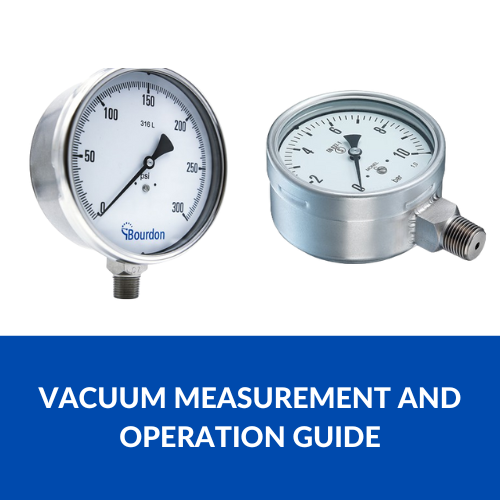A Practical Guide to Vacuum Measurement and Operation
Accurate vacuum measurement is not just a technical detail but a critical necessity across various fields such as scientific research, food packaging, and semiconductor manufacturing. Achieving precision in vacuum pressure can often be the deciding factor between success and failure in many operations. This guide will walk you through everything you need to know about vacuum pressure measurement, from basic concepts to advanced tips for maintaining accuracy.

## Understanding the Fundamentals of Vacuum Measurement
Vacuum pressure refers to the pressure inside a vacuum system relative to the surrounding atmospheric pressure. On the other hand, absolute pressure measures the total pressure against a zero-pressure reference or perfect vacuum. Grasping the difference between these two is vital for precise vacuum measurement.
A vacuum gauge plays a pivotal role in determining the degree of vacuum within a system. These instruments are essential for ensuring that the system operates efficiently and safely within its specified parameters.
## Types of Vacuum Gauges
### Mechanical Gauges
The most straightforward types of vacuum gauges are mechanical ones. Devices like the Bourdon tube and diaphragm gauges utilize the movement of physical components to measure pressure. They are commonly used in low to medium vacuum applications.
### Thermal Conductivity Gauges
Thermal conductivity gauges, such as the Pirani gauge, determine vacuum pressure by assessing a gas’s ability to conduct heat. These gauges are ideal for mid-range vacuum applications where higher sensitivity is required.
### Ionization Gauges
For ultra-high vacuum environments, ionization gauges are indispensable. These gauges calculate pressure by ionizing the gas in the vacuum and monitoring the resulting current. They are particularly valuable in scenarios where extreme accuracy is paramount.
### Choosing the Right Gauge
Selecting the appropriate vacuum gauge depends on your specific needs. While thermal conductivity gauges offer precise readings, mechanical gauges are suitable for general purposes. For ultra-high vacuums, ionization gauges are the preferred choice.
## Achieving Precision in Vacuum Measurement
### Steps for Accurate Vacuum Measurement
To measure vacuum pressure accurately, begin with thorough preparation. Ensure your vacuum system is free of contaminants and properly clean any surfaces. Next, position the vacuum gauge correctly within the system, as improper placement can significantly affect readings. Regular calibration of your gauge is also essential to maintain accuracy.
### Common Mistakes in Vacuum Measurement
One of the most common errors in vacuum measurement is neglecting to calibrate the gauge regularly. Over time, gauges can drift from their original settings, leading to inaccurate readings. Incorrect gauge placement is another frequent issue that can result in misleading measurements.
## Practical Applications of Vacuum Measurement
### Industrial Use Cases
Accurate vacuum measurement is indispensable in various industries. In semiconductor manufacturing, precise control over vacuum pressure is critical to prevent contamination. Similarly, food packaging relies on vacuum pressure to preserve product freshness.
### Scientific Research
In laboratories, vacuum pressure is often a key variable. Whether conducting physics, chemistry, or biology experiments, accurate vacuum gauge measurements ensure consistent and reproducible conditions.
### Maintenance and Troubleshooting
Precise vacuum measurement is also vital for diagnosing and resolving issues within vacuum systems. Monitoring vacuum pressure helps identify leaks, blockages, and other problems that could hinder performance.
## Best Practices for Working in a Vacuum Environment
### Safety Precautions
Working with vacuums involves certain risks, so it’s crucial to follow safety protocols. Always ensure your vacuum gauge is in good condition and be aware of the specific hazards associated with your vacuum system.
### Routine Maintenance
Regular maintenance is essential for maintaining accuracy. This includes cleaning, calibrating, and replacing components as needed.
### Advanced Techniques
For those working in challenging environments, achieving higher accuracy may require more advanced techniques, such as differential measurement or cross-referencing data from multiple gauges.
If you’re looking to elevate your vacuum measurement capabilities, consider investing in top-tier tools. At Transmitter Shop, we offer a wide array of high-quality vacuum gauges and transmitters designed to provide precise and reliable readings. Don’t settle for anything less than excellence—explore our selection today and find the perfect solution for your needs. Contact us to get started!
This guide aims to equip you with the knowledge and tools necessary to master vacuum measurement. Whether you’re a professional in the field or simply curious about the science behind it, understanding vacuum measurement is a skill that can enhance countless projects and processes.
High Neck Flange ,Forged Steel Pipe Flange,Forged Steel Flat Flange,Steel High Neck Flanges
Jiangyin Senoy Trade Co.,LTD , https://www.senoyflange.com